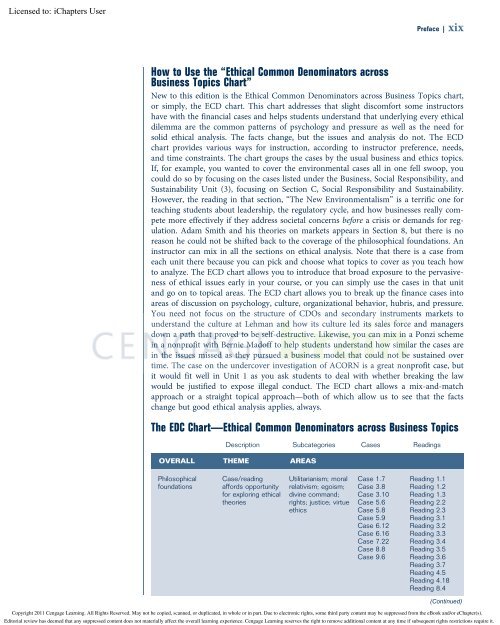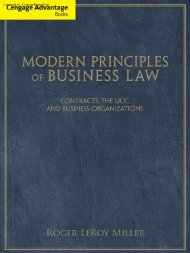Business Ethics: Case Studies and Selected Readings, 7th ed.
Business Ethics: Case Studies and Selected Readings, 7th ed.
Business Ethics: Case Studies and Selected Readings, 7th ed.
Create successful ePaper yourself
Turn your PDF publications into a flip-book with our unique Google optimized e-Paper software.
Licens<strong>ed</strong> to:<br />
Preface | xix<br />
How to Use the “Ethical Common Denominators across<br />
<strong>Business</strong> Topics Chart”<br />
New to this <strong>ed</strong>ition is the Ethical Common Denominators across <strong>Business</strong> Topics chart,<br />
or simply, the ECD chart. This chart addresses that slight discomfort some instructors<br />
have with the financial cases <strong>and</strong> helps students underst<strong>and</strong> that underlying every ethical<br />
dilemma are the common patterns of psychology <strong>and</strong> pressure as well as the ne<strong>ed</strong> for<br />
solid ethical analysis. The facts change, but the issues <strong>and</strong> analysis do not. The ECD<br />
chart provides various ways for instruction, according to instructor preference, ne<strong>ed</strong>s,<br />
<strong>and</strong> time constraints. The chart groups the cases by the usual business <strong>and</strong> ethics topics.<br />
If, for example, you want<strong>ed</strong> to cover the environmental cases all in one fell swoop, you<br />
could do so by focusing on the cases list<strong>ed</strong> under the <strong>Business</strong>, Social Responsibility, <strong>and</strong><br />
Sustainability Unit (3), focusing on Section C, Social Responsibility <strong>and</strong> Sustainability.<br />
However, the reading in that section, “The New Environmentalism” is a terrific one for<br />
teaching students about leadership, the regulatory cycle, <strong>and</strong> how businesses really compete<br />
more effectively if they address societal concerns before a crisis or dem<strong>and</strong>s for regulation.<br />
Adam Smith <strong>and</strong> his theories on markets appears in Section 8, but there is no<br />
reason he could not be shift<strong>ed</strong> back to the coverage of the philosophical foundations. An<br />
instructor can mix in all the sections on ethical analysis. Note that there is a case from<br />
each unit there because you can pick <strong>and</strong> choose what topics to cover as you teach how<br />
to analyze. The ECD chart allows you to introduce that broad exposure to the pervasiveness<br />
of ethical issues early in your course, or you can simply use the cases in that unit<br />
<strong>and</strong> go on to topical areas. The ECD chart allows you to break up the finance cases into<br />
areas of discussion on psychology, culture, organizational behavior, hubris, <strong>and</strong> pressure.<br />
You ne<strong>ed</strong> not focus on the structure of CDOs <strong>and</strong> secondary instruments markets to<br />
underst<strong>and</strong> the culture at Lehman <strong>and</strong> how its culture l<strong>ed</strong> its sales force <strong>and</strong> managers<br />
down a path that prov<strong>ed</strong> to be self-destructive. Likewise, you can mix in a Ponzi scheme<br />
in a nonprofit with Bernie Madoff to help students underst<strong>and</strong> how similar the cases are<br />
in the issues miss<strong>ed</strong> as they pursu<strong>ed</strong> a business model that could not be sustain<strong>ed</strong> over<br />
time. The case on the undercover investigation of ACORN is a great nonprofit case, but<br />
it would fit well in Unit 1 as you ask students to deal with whether breaking the law<br />
would be justifi<strong>ed</strong> to expose illegal conduct. The ECD chart allows a mix-<strong>and</strong>-match<br />
approach or a straight topical approach—both of which allow us to see that the facts<br />
change but good ethical analysis applies, always.<br />
The EDC Chart—Ethical Common Denominators across <strong>Business</strong> Topics<br />
Description Subcategories <strong>Case</strong>s <strong>Readings</strong><br />
OVERALL THEME AREAS<br />
Philosophical<br />
foundations<br />
<strong>Case</strong>/reading<br />
affords opportunity<br />
for exploring ethical<br />
theories<br />
Utilitarianism; moral<br />
relativism; egoism;<br />
divine comm<strong>and</strong>;<br />
rights; justice; virtue<br />
ethics<br />
<strong>Case</strong> 1.7<br />
<strong>Case</strong> 3.8<br />
<strong>Case</strong> 3.10<br />
<strong>Case</strong> 5.6<br />
<strong>Case</strong> 5.8<br />
<strong>Case</strong> 5.9<br />
<strong>Case</strong> 6.12<br />
<strong>Case</strong> 6.16<br />
<strong>Case</strong> 7.22<br />
<strong>Case</strong> 8.8<br />
<strong>Case</strong> 9.6<br />
Reading 1.1<br />
Reading 1.2<br />
Reading 1.3<br />
Reading 2.2<br />
Reading 2.3<br />
Reading 3.1<br />
Reading 3.2<br />
Reading 3.3<br />
Reading 3.4<br />
Reading 3.5<br />
Reading 3.6<br />
Reading 3.7<br />
Reading 4.5<br />
Reading 4.18<br />
Reading 8.4<br />
(Continu<strong>ed</strong>)<br />
Copyright 2011 Cengage Learning. All Rights Reserv<strong>ed</strong>. May not be copi<strong>ed</strong>, scann<strong>ed</strong>, or duplicat<strong>ed</strong>, in whole or in part. Due to electronic rights, some third party content may be suppress<strong>ed</strong> from the eBook <strong>and</strong>/or eChapter(s).<br />
Editorial review has deem<strong>ed</strong> that any suppress<strong>ed</strong> content does not materially affect the overall learning experience. Cengage Learning reserves the right to remove additional content at any time if subsequent rights restrictions require it.










